INTRODUCTION
We went to Lesvos in 2001 with our friends Pat & Judy Hayes, who were kind enough to show us around the island. We travelled with Olympic Airways from London to Athens and then onwards to Lesvos and experienced one of our scariest moments ever whilst landing at Mytilini in an exceptionally strong cross wind. When Pat told us in May 2004 they were going to Lesvos again in 2005 we jumped at the chance to join them on this magical birding island. Taking no chances this time with small planes from Athens, we flew from Manchester on one of the earliest packages available.
FLIGHTS, CAR HIRE AND ACCOMODATION
Flights – First Choice from Manchester to Mytilini on 5th May returning 12th May 2005. Booked online in June 2004 at a joint cost of £420. Manchester departure of 07.40hrs was a little early but at least arriving in Lesvos at 13.30hrs gave us plenty daylight to get to our ultimate destination. Return flight at 14.30hrs was ideal, arriving in the UK at 16.30hrs. Although the flights were OK, seating was very cramped (extra legroom was available at £30 each per flight!) and meals (also purchased as an extra at £10 each) were adequate. Check-in at Manchester was appalling, with a long snaking rope queue leading to 5/6 check-in desks for all First Choice's flights. When we eventually reached our desk we were confronted with a rather frayed 50/60 year old male check-in clerk, who had probably reached the zenith of his career many years previously, and stayed there. He brusquely announced our hand luggage, although within the stipulated size requirements and overall total allowance, was too heavy for health and safety regulations in one bag and would have to be re-packed. Luckily we had another empty lightweight rucksack in one of our cases and we were able to oblige. Our cases then weighed in at 8 kilos over the meagre 20 kilos allowance (2 scopes, tripods, books, cameras etc soon add up) which cost us a further £32 (£4 per kilo). One of our longest and most uncomfortable check-ins ever. Suffice it to say we will not be flying with First Choice again…..if they are the only option, we won't go. Check-in at Mytilini was easy in comparison.
Car Hire – Booked on line with Holiday Autos www.holidayautos.co.uk in October 2004 with pick up and drop off at Mytilini airport. Car provided locally by Hertz Greece at a cost of £174.50 for the week including damage excess refund. Hertz also provided a useful map of the island. Pick up and return was quite painless with excellent service from the local representatives at the airport.
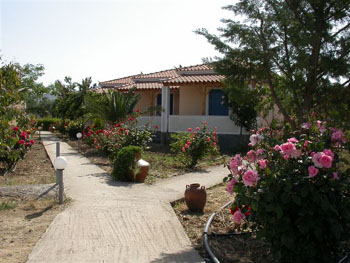 Accommodation – Oasis apartments, Skala Kalloni at £175 for the week, arranged with Nature Photography Pro-Tours who we had previously used in 2001. The apartments are owned and managed by George Kasios who can be contacted on (0253) 95381 – 24190. Although the one-roomed apartment was fairly basic, it was clean, had air conditioning/heating, came equipped with electric kettle, electric hob and fridge and had maid service once during the week, when beds and towels were changed. We did have a minor problem with ants at the start but a visit to the supermarket soon cured it. At the entrance to the Potamia Valley, just outside Skala Kalloni, it proved to be an excellent base to bird the most productive areas.
Accommodation – Oasis apartments, Skala Kalloni at £175 for the week, arranged with Nature Photography Pro-Tours who we had previously used in 2001. The apartments are owned and managed by George Kasios who can be contacted on (0253) 95381 – 24190. Although the one-roomed apartment was fairly basic, it was clean, had air conditioning/heating, came equipped with electric kettle, electric hob and fridge and had maid service once during the week, when beds and towels were changed. We did have a minor problem with ants at the start but a visit to the supermarket soon cured it. At the entrance to the Potamia Valley, just outside Skala Kalloni, it proved to be an excellent base to bird the most productive areas.
TRIP ESSENTIALS
 Birding on the Greek Island of Lesvos – Richard Brooks ISBN 0 9527249 2 8
Birding on the Greek Island of Lesvos – Richard Brooks ISBN 0 9527249 2 8
Lesvos Update Autumn '03 – Summer '04 – Richard Brooks ISBN 0 9527249 8 7
Lesvos Road Map ISBN 960 8481 92 9
Bird ID book of preference – Collins Bird Guide ISBN 0 00 219728 6 is better than most.
FOOD AND WEATHER
 Local supermarkets provide all the essentials for self-catering. We were out each morning at 6.30hrs and returned to the apartment for breakfast around 9.00hrs via the bakery in Skala Kalloni for our daily picnic rations. In the evenings we always eat out and on this trip we remained faithful to the Seahorse Restaurant near the harbour in Skala Kalloni as the prices are reasonable an the meals are good, provided you ask for hot soup and you don't mind cool vegetables with the main course.
Local supermarkets provide all the essentials for self-catering. We were out each morning at 6.30hrs and returned to the apartment for breakfast around 9.00hrs via the bakery in Skala Kalloni for our daily picnic rations. In the evenings we always eat out and on this trip we remained faithful to the Seahorse Restaurant near the harbour in Skala Kalloni as the prices are reasonable an the meals are good, provided you ask for hot soup and you don't mind cool vegetables with the main course.
When we arrived the sun was shining but there was a cool breeze. The next day the wind dropped and temperatures rose. The following day, Saturday, it was overcast and blowing a gale. That evening we were advised it needed to rain or else the weather would continue in this vein for several days. Thankfully it rained heavily during the night for about 30 minutes and the next morning was warm, clear and sunny and this is how the weather continued for the remainder of the week. Temperatures reached 24-26C.
ITINERARY AND DIARY
May 5th Depart Manchester a little later than anticipated but with a flight time of 3hrs 20mins we arrived in Mytilene more or less on schedule and, having picked up the car promptly, driven over to the apartment to drop our 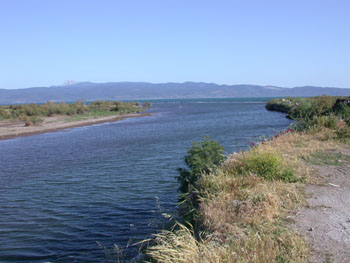 cases and visited the supermarket for provisions, we were out birding by 16.00hrs along the East River and eventually to the Salt Pans. Our re-introduction to the area produced 42 species in about 3 hrs including our only Curlew of the trip at the mouth of the river, 2 Temminck's Stint feeding on the river margins with a small party of Little Stint and close up views of a singing Nightingale almost out on the top branches of a riverside bush. Although the Salt Pans produced most of the expected species, numbers were lower than anticipated with settled weather earlier in the year having encouraged many of the spring migrants to hasten their journeys northwards a little earlier than usual. Two Black Terns lingered with a party of c20 White-winged Terns and we had a fleeting glimpse of our only three Spotted Redshanks of the trip.
cases and visited the supermarket for provisions, we were out birding by 16.00hrs along the East River and eventually to the Salt Pans. Our re-introduction to the area produced 42 species in about 3 hrs including our only Curlew of the trip at the mouth of the river, 2 Temminck's Stint feeding on the river margins with a small party of Little Stint and close up views of a singing Nightingale almost out on the top branches of a riverside bush. Although the Salt Pans produced most of the expected species, numbers were lower than anticipated with settled weather earlier in the year having encouraged many of the spring migrants to hasten their journeys northwards a little earlier than usual. Two Black Terns lingered with a party of c20 White-winged Terns and we had a fleeting glimpse of our only three Spotted Redshanks of the trip.
May 6th Early morning visit to the Inland Lake followed by the Salt Pans and a brief visit to the West River on our return to catch 5 Stone-curlews and our only Great Egret of the trip. Most of our early morning visits to the 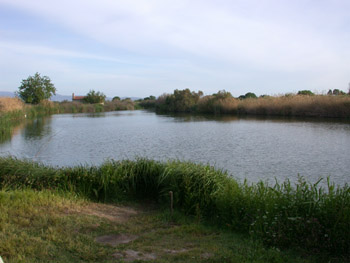 Inland Lake were brief as it tended to be crowded, with all and sundry out of their cars and tour vans, lining the banks with tripods, scopes etc and chattering loudly. Not a good recipe for quiet skulking Little Crakes etc., but we did manage to spot our first elusive Cetti's Warbler before beating a hasty retreat. After breakfast we made the first of 3 or 4 abortive trips to the small wooded area near the mini football pitch just past the turn off to Dafia & Filia on the Petra road, just north of Kalloni. Scops Owl and two young Long-eared Owls had been roosting here and easy to find, up to the previous day! We did have the consolation of seeing Middle-spotted Woodpecker feeding young in its nest hole. Later we went to the Goat Pit by the East River, where, over our picnic lunch at the roadside we had excellent views of a singing Rufous-tailed Scrub-robin and watched Black-eared Wheatear, Orphean Warbler and Cretzschmar's Buntings collecting food for their young. As the day heated up we moved on to the secluded small lake above the Goat Pit.
Inland Lake were brief as it tended to be crowded, with all and sundry out of their cars and tour vans, lining the banks with tripods, scopes etc and chattering loudly. Not a good recipe for quiet skulking Little Crakes etc., but we did manage to spot our first elusive Cetti's Warbler before beating a hasty retreat. After breakfast we made the first of 3 or 4 abortive trips to the small wooded area near the mini football pitch just past the turn off to Dafia & Filia on the Petra road, just north of Kalloni. Scops Owl and two young Long-eared Owls had been roosting here and easy to find, up to the previous day! We did have the consolation of seeing Middle-spotted Woodpecker feeding young in its nest hole. Later we went to the Goat Pit by the East River, where, over our picnic lunch at the roadside we had excellent views of a singing Rufous-tailed Scrub-robin and watched Black-eared Wheatear, Orphean Warbler and Cretzschmar's Buntings collecting food for their young. As the day heated up we moved on to the secluded small lake above the Goat Pit. 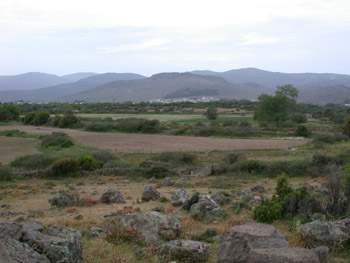 Feeling the heat as we returned to the cars, I asked Amanda, Judy and Pat to avert their gaze as I wished to change my trousers for shorts. They duly obliged and I started to change by the boot of our car. With one leg out and my trousers around my ankles, I leaned against the car for balance. Imagine my horror as the car started to roll down the fairly steep track – I had left it in neutral and forgotten the handbrake – clever! No doubt you are getting the picture. “Trouserless male strong man seen clinging onto car boot as vehicle careers downhill out of control”. Luckily I managed to slow the descent enough for Amanda to apply the brake, although she could hardly manage it for laughing. Needless to say Pat and Judy were of little help, they could hardly see for the tears in their eyes. Anyway, moving swiftly on…… to the Kruper's Nuthatch site in the area known as Derbyshire where we saw two birds feeding young in the nest and I managed to get stung by a bee, underneath my big toe. Amanda kindly removed the sting and applied some magic lotion which Judy just happened to have in her bag. She is well known for carrying the solutions to all the world's problems in her little shoulder bag! We returned via the Salt Pans where we picked up our first Marsh Sandpiper, a Greenshank and two pristine Mediterranean Gulls amongst others. 58 birds for the day with the trip list now well into the seventies.
Feeling the heat as we returned to the cars, I asked Amanda, Judy and Pat to avert their gaze as I wished to change my trousers for shorts. They duly obliged and I started to change by the boot of our car. With one leg out and my trousers around my ankles, I leaned against the car for balance. Imagine my horror as the car started to roll down the fairly steep track – I had left it in neutral and forgotten the handbrake – clever! No doubt you are getting the picture. “Trouserless male strong man seen clinging onto car boot as vehicle careers downhill out of control”. Luckily I managed to slow the descent enough for Amanda to apply the brake, although she could hardly manage it for laughing. Needless to say Pat and Judy were of little help, they could hardly see for the tears in their eyes. Anyway, moving swiftly on…… to the Kruper's Nuthatch site in the area known as Derbyshire where we saw two birds feeding young in the nest and I managed to get stung by a bee, underneath my big toe. Amanda kindly removed the sting and applied some magic lotion which Judy just happened to have in her bag. She is well known for carrying the solutions to all the world's problems in her little shoulder bag! We returned via the Salt Pans where we picked up our first Marsh Sandpiper, a Greenshank and two pristine Mediterranean Gulls amongst others. 58 birds for the day with the trip list now well into the seventies.
May 7th Finding the usual crowd (Birdscarers I think the name was on the two mini-vans) at the Inland Lake we swiftly moved on to Devil's Bridge. There was a massive movement of Hirundines going on over the lake in very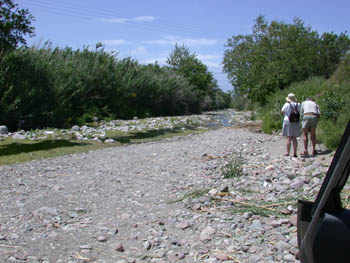 windy, overcast conditions and we saw our first of two Purple Herons. At Devil's Bridge birds were far and few between with most apparently sheltering from the elements. When we previously visited the island Cinereous Bunting was breeding here, but not this year. Returning to the apartment we saw a Black Stork by the roadside at Parakila Marsh. After breakfast we went to Faneromeni Ford via Agra, where we saw a migrating flock of c100 Bee-eaters, with many roosting overhead for a time in a roadside tree. Despite the elements we managed our first windblown Isabelline Wheatear at the well known site by the Sigri turn off on the Eressos-Vatoussa road. However we decided to leave Ipsilou Monastery for another day. On the track from Sigri to Faneromeni we encountered our only pair of Alpine Swifts and Lesser Kestrels, hunting over the coastal fields. At Faneromeni we had amazing close ups of a male Little Bittern feeding from an overhanging branch on the millions of tadpoles in the “river”. Over lunch at the ford we also had several Wood Sandpipers, Marsh Sandpiper, Greenshank, 2 Ruff, Squacco Heron and Spotted Flycatcher together with the only Yellow Wagtail (of the nominate race) of the trip. Returning via the Grand Canyon we called in at the Perivolis Monastery where previously we had seen Black-crowned Night-heron and a number of woodland species. Big mistake – see later.
windy, overcast conditions and we saw our first of two Purple Herons. At Devil's Bridge birds were far and few between with most apparently sheltering from the elements. When we previously visited the island Cinereous Bunting was breeding here, but not this year. Returning to the apartment we saw a Black Stork by the roadside at Parakila Marsh. After breakfast we went to Faneromeni Ford via Agra, where we saw a migrating flock of c100 Bee-eaters, with many roosting overhead for a time in a roadside tree. Despite the elements we managed our first windblown Isabelline Wheatear at the well known site by the Sigri turn off on the Eressos-Vatoussa road. However we decided to leave Ipsilou Monastery for another day. On the track from Sigri to Faneromeni we encountered our only pair of Alpine Swifts and Lesser Kestrels, hunting over the coastal fields. At Faneromeni we had amazing close ups of a male Little Bittern feeding from an overhanging branch on the millions of tadpoles in the “river”. Over lunch at the ford we also had several Wood Sandpipers, Marsh Sandpiper, Greenshank, 2 Ruff, Squacco Heron and Spotted Flycatcher together with the only Yellow Wagtail (of the nominate race) of the trip. Returning via the Grand Canyon we called in at the Perivolis Monastery where previously we had seen Black-crowned Night-heron and a number of woodland species. Big mistake – see later.  In the “Canyon” we saw overflying Buzzards, Long-legged Buzzard and Crag Martins together with a nesting Rock Nuthatch. We stopped a number of times before returning to the apartment, especially between Filia and Dafia, where we had Red-breasted Flycatcher, Northern Wheatear, c5 Stonechats, 3 Black-eared Wheatears and a similar number of Cretzschmar's Buntings by the roadside. Only 52 birds for the day but the trip list was now in the mid eighties.
In the “Canyon” we saw overflying Buzzards, Long-legged Buzzard and Crag Martins together with a nesting Rock Nuthatch. We stopped a number of times before returning to the apartment, especially between Filia and Dafia, where we had Red-breasted Flycatcher, Northern Wheatear, c5 Stonechats, 3 Black-eared Wheatears and a similar number of Cretzschmar's Buntings by the roadside. Only 52 birds for the day but the trip list was now in the mid eighties.
May 8th Overnight rain took care of the winds and the sun and warmth returned to see us at the Salt Pans to start the day on the track at the far eastern end of the pans with the sun behind our backs. 8 Grey Plovers were sitting on a wall (no, not the song!) in the distance and we had c6 Redshanks on a bank between the pans, the only birds of the trip, plus two Little Gulls and a single Whinchat. To keep away from the locals, as it was Sunday, we decided to walk from the apartment up the Potamia Valley for about 4 miles. On a 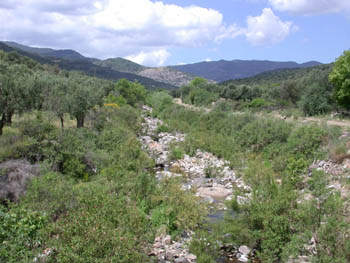 scorching hot day we had a picnic lunch in an Olive grove surrounded by birds, butterflies (including Scarce Swallowtail), flying insects etc. Birds included Subalpine Warbler, several Masked Shrikes and a Cirl Bunting, together with overflying Buzzards, Long-legged Buzzards, Peregrine, Short-toed Eagles and up to 3 Honey-buzzards, one of which flew right over our heads with a massive live snake, about 3ft long, in its talons. Having returned to the apartment around 15.15hrs we decided to take a trip around the East River and Salt Pans (gluttons for punishment) and recorded a Black Stork together with 2 quartering Marsh Harriers and the other usual suspects. 58 birds today with the list now approaching 100.
scorching hot day we had a picnic lunch in an Olive grove surrounded by birds, butterflies (including Scarce Swallowtail), flying insects etc. Birds included Subalpine Warbler, several Masked Shrikes and a Cirl Bunting, together with overflying Buzzards, Long-legged Buzzards, Peregrine, Short-toed Eagles and up to 3 Honey-buzzards, one of which flew right over our heads with a massive live snake, about 3ft long, in its talons. Having returned to the apartment around 15.15hrs we decided to take a trip around the East River and Salt Pans (gluttons for punishment) and recorded a Black Stork together with 2 quartering Marsh Harriers and the other usual suspects. 58 birds today with the list now approaching 100.
May 9th Where else but the Salt Pans once again as the Inland Lake was still too crowded. Unusually for early morning we decided to walk around the sheep fields between the pans and the sea and risk the sun in our eyes. Over the water we had our only Cormorant of the week and two Squacco Herons roosting on a wooden pier. 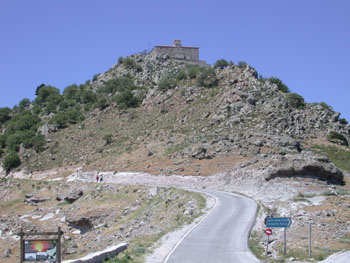 We had distant views of Stone-curlew and also saw singing Short-toed Lark and Rufous-tailed Scrub-robin before spotting a Collared Pratincole amongst a sizeable migrating flock of Swifts. We enjoyed wonderful views of the Pratincole flying low overhead for about 15 minutes before it moved on with the Swifts. Ipsilou Monastery beckoned after breakfast and in much calmer conditions we had good views of up to 3 Isabelline Wheatears on the way. Despite winds having dropped elsewhere, at the monastery they were still very strong. Thankfully the road up to the top was relatively sheltered and we decided to enjoy the walk. We were rewarded with c5 Long-legged Buzzards, 2 Blue Rock-thrushes, the only Garden Warbler of the trip, c5 Rock Nuthatches, 3 Cirl Buntings, numerous Cretzschmar's Buntings and c3 Cinereous Buntings with at least 2 singing males and one female. From the monastery we moved on to the Chousos ford and onwards to Tavari where we had good views of a pair of Little Bittern in the river as it approaches the sea. On the track to the ford we saw Orphean Warbler and our only pair of Sombre Tits of the trip. We returned via Agra where we were surprised to find a singing male Cinereous Bunting near the round buildings at the top of the hill above the town – we were actually hoping for Rock Sparrow which we found elusive throughout the week. We also saw our only Linnet of the trip by the roadside a little after Agra. 63 birds today with the list topping 100.
We had distant views of Stone-curlew and also saw singing Short-toed Lark and Rufous-tailed Scrub-robin before spotting a Collared Pratincole amongst a sizeable migrating flock of Swifts. We enjoyed wonderful views of the Pratincole flying low overhead for about 15 minutes before it moved on with the Swifts. Ipsilou Monastery beckoned after breakfast and in much calmer conditions we had good views of up to 3 Isabelline Wheatears on the way. Despite winds having dropped elsewhere, at the monastery they were still very strong. Thankfully the road up to the top was relatively sheltered and we decided to enjoy the walk. We were rewarded with c5 Long-legged Buzzards, 2 Blue Rock-thrushes, the only Garden Warbler of the trip, c5 Rock Nuthatches, 3 Cirl Buntings, numerous Cretzschmar's Buntings and c3 Cinereous Buntings with at least 2 singing males and one female. From the monastery we moved on to the Chousos ford and onwards to Tavari where we had good views of a pair of Little Bittern in the river as it approaches the sea. On the track to the ford we saw Orphean Warbler and our only pair of Sombre Tits of the trip. We returned via Agra where we were surprised to find a singing male Cinereous Bunting near the round buildings at the top of the hill above the town – we were actually hoping for Rock Sparrow which we found elusive throughout the week. We also saw our only Linnet of the trip by the roadside a little after Agra. 63 birds today with the list topping 100.
May 10th You guessed! Salt Pans to start the day with 2 roosting Black Stork, Marsh Harrier, 2 photogenic Little Gulls, Gull-billed Tern, and 2 Black-headed Wagtails plus the usual Red-backed shrikes and a cast of hundreds. After breakfast we headed up the Napi Valley to the Olive-tree Warbler site. On the way we had 5 Red-footed Falcons, and 2 Hoopoes. 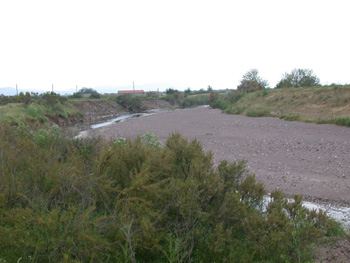 At the site itself we had Honey-buzzard, 2 Long-legged Buzzards, single Eleanora's Falcon, Golden Oriole, a pair of nesting Masked Shrikes, Sparrowhawk, Middle-spotted Woodpecker, Woodlark, Hawfinch, a number of singing Orphean Warblers, Cirl Bunting and about 5 singing Olive-tree Warblers, some of which were out in the open singing from a tree top for up to 5 minutes at a time. As I only had a very fleeting glimpse of the Warbler on our last visit this was a highlight for me and a lifer for Amanda. After our picnic lunch we headed to the Derbyshire area where a Spur-winged Plover had taken up brief residence in the pools by the turn off from the main road from Kalloni to Mytilene. On the way back to the apartment we visited the Salt Pans (of course) where we had 4 Collared Pratincoles, a flock of c40 Whiskered Terns plus the usual single Sanderling and small flock of Curlew Sandpipers, some of which were in magnificent breeding plumage. On our return we decided to eat a little later and went for a flying visit to the Inland Lake, hoping for peace and quiet. We were rewarded with two very confiding Black-crowned Night-herons, a Reed Warbler and a Great Reed Warbler. Probably the best day's birding of the week! Today saw 66 birds with the species total approaching 120.
At the site itself we had Honey-buzzard, 2 Long-legged Buzzards, single Eleanora's Falcon, Golden Oriole, a pair of nesting Masked Shrikes, Sparrowhawk, Middle-spotted Woodpecker, Woodlark, Hawfinch, a number of singing Orphean Warblers, Cirl Bunting and about 5 singing Olive-tree Warblers, some of which were out in the open singing from a tree top for up to 5 minutes at a time. As I only had a very fleeting glimpse of the Warbler on our last visit this was a highlight for me and a lifer for Amanda. After our picnic lunch we headed to the Derbyshire area where a Spur-winged Plover had taken up brief residence in the pools by the turn off from the main road from Kalloni to Mytilene. On the way back to the apartment we visited the Salt Pans (of course) where we had 4 Collared Pratincoles, a flock of c40 Whiskered Terns plus the usual single Sanderling and small flock of Curlew Sandpipers, some of which were in magnificent breeding plumage. On our return we decided to eat a little later and went for a flying visit to the Inland Lake, hoping for peace and quiet. We were rewarded with two very confiding Black-crowned Night-herons, a Reed Warbler and a Great Reed Warbler. Probably the best day's birding of the week! Today saw 66 birds with the species total approaching 120.
May 11th First thing we once again tried the Inland Lake, where, despite the massed ranks of Birdscarers all standing noisily with scopes, tripods and cameras at the ready, immediately opposite the anticipated appearance spot of their quarry, I had a fleeting glimpse of a very wary Little Crake. Unfortunately the rest of our party missed out, but Pat and Judy saw a Water Rail whilst I was looking for the Crake and we all had good views of a Purple Heron sitting quite unconcerned on top of one of the waterside bushes. 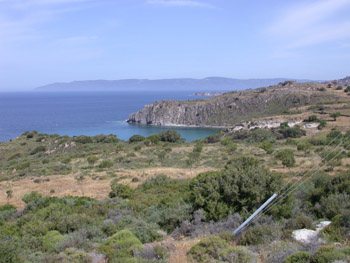 An obliging Cetti's Warbler put in a brief appearance at the lake and we saw our 4th Lesser Grey Shrike on the way to the lake. A brief trip to the Salt Pans before breakfast produced nothing new other than our only Common Sandpiper of the trip. We then moved on to Petra/Molivos to the well known Ruppell's Warbler site where we had a fleeting distant glimpse of a bird from the lay-by. Subsequently we saw at least four birds, down to 5 metres, up the hillside track opposite the lay-by, along with 2 Subalpine Warblers. Next we went to Petra Reservoir and saw lots of gulls and little else. On the way back to Kalloni we had a late picnic lunch at the “Bandstand” overlooking Kalloni Bay, with on-looking Black Stork, 2 White Storks, Peregrine, Jay, Blue Rock-thrush and a number of Rock Nuthatches and Black-eared Wheatears. Before returning to the apartment we once again returned to the Salt Pans where we had astounding views of a single Collared Pratincole down to 10 metres, hawking insects on one of the sheep fields behind the pans. 2 Mediterranean Gulls, single female Hen Harrier, Pallid Harrier and 2 Short-toed Larks made up the supporting cast. 67 birds today with the overall total still moving along nicely.
An obliging Cetti's Warbler put in a brief appearance at the lake and we saw our 4th Lesser Grey Shrike on the way to the lake. A brief trip to the Salt Pans before breakfast produced nothing new other than our only Common Sandpiper of the trip. We then moved on to Petra/Molivos to the well known Ruppell's Warbler site where we had a fleeting distant glimpse of a bird from the lay-by. Subsequently we saw at least four birds, down to 5 metres, up the hillside track opposite the lay-by, along with 2 Subalpine Warblers. Next we went to Petra Reservoir and saw lots of gulls and little else. On the way back to Kalloni we had a late picnic lunch at the “Bandstand” overlooking Kalloni Bay, with on-looking Black Stork, 2 White Storks, Peregrine, Jay, Blue Rock-thrush and a number of Rock Nuthatches and Black-eared Wheatears. Before returning to the apartment we once again returned to the Salt Pans where we had astounding views of a single Collared Pratincole down to 10 metres, hawking insects on one of the sheep fields behind the pans. 2 Mediterranean Gulls, single female Hen Harrier, Pallid Harrier and 2 Short-toed Larks made up the supporting cast. 67 birds today with the overall total still moving along nicely.
May 12th Time to go home, but first a last visit to the Salt Pans, what else? Last sightings of Ruddy Shelduck (only our third bird), Peregrine, 6 Ringed Plovers (only one previous sighting) female Pallid Harrier, Sandwich Tern (second only), Rufous-tailed Scrub-robin, and up to 5 Collared Pratincoles were a bonus on the last day. Breakfast and final packing over we heard an unusual commotion outside the apartment: 15 Mediterranean Gulls were calling overhead as they flew in from the West River mouth across the Potamia Valley. We then headed to Skala Kalloni harbour for a cheap tick with the long staying tame White Pelican. On the way to the airport we had an hour to spare and spent it at the Kruper's Nuthatch site in Derbyshire, where in addition to the nuthatches, we added c5 Short-toed Treecreepers, Serin and Long-tailed Tit (A. c. tephronotus race) to our already more than satisfactory list. 47 birds for the day and 128 species in total.
SITE REVIEW AND DIRECTIONS
The details and directions to all the well known sites are more than adequately outlined in Richard Brooks's books.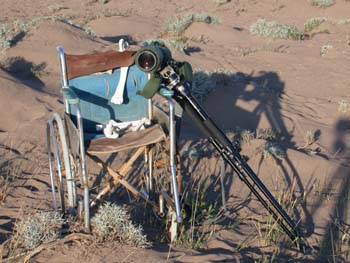 There are, however, one or two areas worthy of comment.
There are, however, one or two areas worthy of comment.
Perivolis Monastery
As soon as we arrived we noticed a strange smell. Walking towards the river it steadily grew worse and it's fair to say the river now appears to be little better than an open sewer. The water is a murky blue-grey and appears totally devoid of life apart from a few hardy Terrapins. Even the surrounding woodland was quiet with very little bird life. Definitely one to cross off the list for the future. Back
Chousos ford
Both Brooks's books and the previous 2001 Lesvos trip report have this as Kroussos ford. The road sign from the Sigri road now has a different spelling. The track to the ford has deteriorated since our last visit and although still driveable, there were some hairy moments. The river bed has recently been flattened and widened, removing most of the previous scrub habitat from the river banks. The river itself flows in a narrow channel to facilitate pumping out for the village farmers' irrigation systems and the stony river bed appears to be used as a new track for local vehicles. On our previous visit this ford was a veritable oasis of birdlife with numerous warblers, wagtails, Little Bittern etc. Now, apart from single singing Black-headed Bunting, Olivaceous Warbler and the departing rump of a Wood Sandpiper, the site was fairly lifeless and will take a number of years to recover. Back
Napi Valley Olive-tree Warbler site
Following the construction of the new road, which obviously caused considerable disturbance to the habitat in the immediate vicinity, the warblers have moved on to a new site a little further along the valley. Approximately 13kms from the turn off by the Salt Pans on the Kalloni-Mytilini road and beyond the town of Napi, there is a sharp right hand bend with a pull off space on the left hand side next to the track leading up to the radio masts on the hillside above. About 20ms further on, on the right hand side of the road, there is a track which cuts back sharply from the road and is hidden until you are upon it. The entrance to the track was quite rough and the best approach is to drive past, turn round and approach from the opposite direction. The track is quite driveable and after c3/4kms there is a stretch of oak woodland on the left side of the track by the first cattle grid. A number of male Olive-tree Warblers were singing and chasing each other around the woods. Approximately 400ms further along the track there is another cattle grid. There was at least one singing male in the woods to the left of the track in the woods by this cattle grid and in between the two cattle grids there appeared to be breeding Woodlark and Hawfinch. Back
SUMMARY
 Bird numbers were a little disappointing in comparison to our visit 4 years ago, but that was two weeks earlier and this year there had been a prolonged period of settled weather in early Spring which seemed to have moved migrants along fairly quickly. For birders new to the island the magic is still the same with the chance of many new species in a largely unspoilt habitat. We saw 128 species in a week and although there were no lifers for me the birding was still very enjoyable most of the time. Some may question the number of visits to the Salt Pans, but this is one of the premier sites on the island with new birds turning up all the time and well worth the attention in my view.
Bird numbers were a little disappointing in comparison to our visit 4 years ago, but that was two weeks earlier and this year there had been a prolonged period of settled weather in early Spring which seemed to have moved migrants along fairly quickly. For birders new to the island the magic is still the same with the chance of many new species in a largely unspoilt habitat. We saw 128 species in a week and although there were no lifers for me the birding was still very enjoyable most of the time. Some may question the number of visits to the Salt Pans, but this is one of the premier sites on the island with new birds turning up all the time and well worth the attention in my view.
Bird Photos 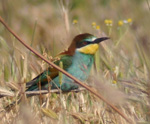
Species List
David and Amanda Mason

